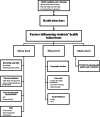A Qualitative Investigation of University Student's Perceptions of Health Behaviours and Associations With Educational Outcomes Through the Lens of the WHO Framework on Health Behaviours and Educational Outcomes
- PMID: 40222725
- PMCID: PMC11994251
- DOI: 10.1002/hpja.70003
A Qualitative Investigation of University Student's Perceptions of Health Behaviours and Associations With Educational Outcomes Through the Lens of the WHO Framework on Health Behaviours and Educational Outcomes
Abstract
Issue addressed: Informed by the World Health Organisation's (WHO) framework on health behaviours and educational outcomes (EO), this study examined university students' perceptions about factors influencing their health behaviours and relationships between health behaviours and EO.
Methods: Data collection involved 12 semi-structured focus groups with 37 domestic and international undergraduate students (32 females; mean age = 20.3 ± 3.43 years) studying in various academic years and programs at the main campus of The University of Queensland. Data analysis included an initial inductive thematic analysis to develop themes, followed by a deductive thematic analysis to map the identified themes onto the WHO framework.
Results: Several themes were identified regarding students' health behaviours, including factors at the micro (knowledge and skills; personal attributes; socio-demographic characteristics; time), meso (geographic location; university; social influences), and macro (COVID-19 related policies and restrictions) levels. Two themes were identified relating to students' perceptions of the relationships between health behaviours and EO (relationships with short-term EO; elements mediating this relationship), with most relevant discussions centred around sleep.
Conclusions: Findings suggest that to optimise university students' health and EO, strategies should target multiple health behaviours and address multiple levels of influence. Interventions focused on time management skills and understanding sedentary behaviour may be particularly useful for this population. SO WHAT?: University students' health behaviours should be addressed with consideration of the educational context and use of contextually relevant frameworks. Promotion efforts should prioritise strategies that address multiple levels of influence, which may result in positive outcomes across multiple health behaviours and EO.
Keywords: educational outcomes; health behaviours; influencing factors; qualitative study; university students.
© 2025 The Author(s). Health Promotion Journal of Australia published by John Wiley & Sons Australia, Ltd on behalf of Australian Health Promotion Association.
Conflict of interest statement
The authors declare no conflicts of interest.
Figures




References
-
- Taylor Z. E., Doane L. D., and Eisenberg N., “Transitioning From High School to College: Relations of Social Support, Ego‐Resiliency, and Maladjustment During Emerging Adulthood,” Emerging Adulthood 2, no. 2 (2014): 105–115.
-
- Peltzer K. and Pengpid S., “Correlates of Healthy Fruit and Vegetable Diet in Students in Low, Middle and High Income Countries,” International Journal of Public Health 60, no. 1 (2015): 79–90. - PubMed
-
- Jiang X. L., Zheng X. Y., Yang J., et al., “A Systematic Review of Studies on the Prevalence of Insomnia in University Students,” Public Health 129, no. 12 (2015): 1579–1584. - PubMed
MeSH terms
Grants and funding
LinkOut - more resources
Full Text Sources

